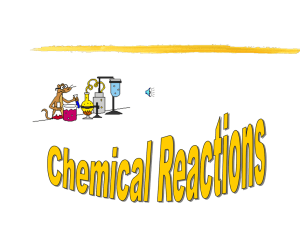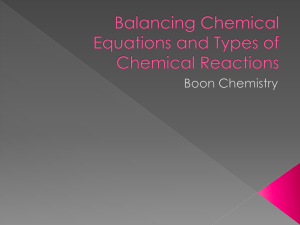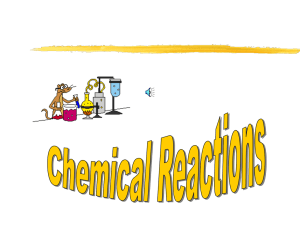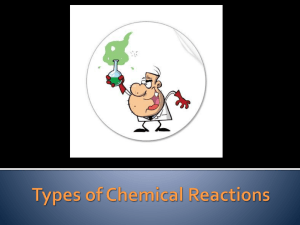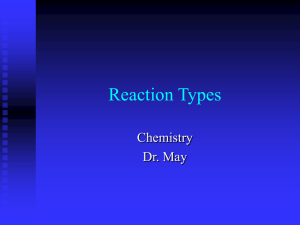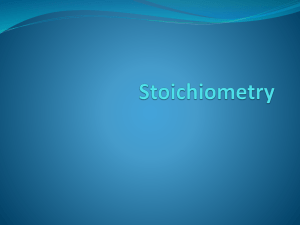Honors Chapter 11 Reactions
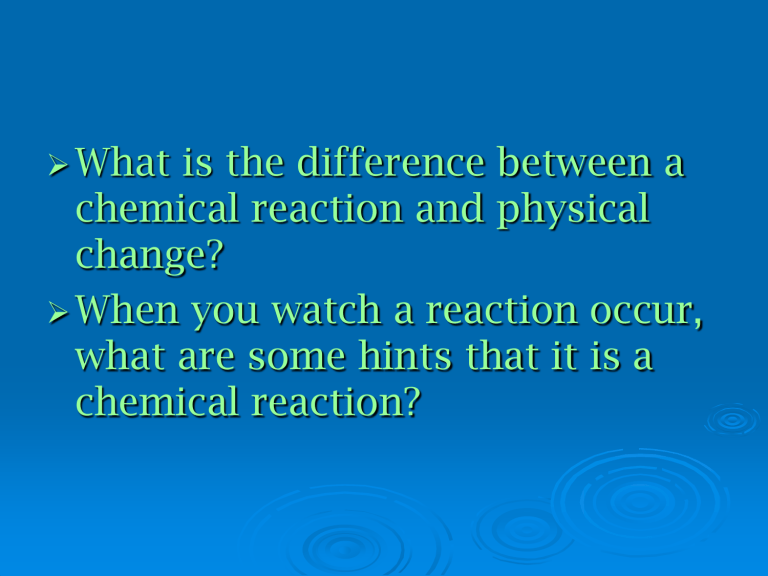
What is the difference between a chemical reaction and physical change?
When you watch a reaction occur, what are some hints that it is a chemical reaction?
Ch. 11 Chemical
Equations Reactions
Describing Chemical Reactions
Objectives
List three observations that suggest that a chemical reaction has taken place.
List three requirements for a correctly written chemical equation.
Write a word equation and a formula equation for a given reaction.
Balance a formula equation by inspection.
Chemical Reactions
when a substance changes identity
reactants- original
products- resulting
law of conservation of mass
total mass of reactants = total mass of products
Chemical Reactions
chemical equation
represents identities and relative amounts of reactants and products in the chemical reaction uses symbols and formulas
Hints of Chemical Rxn
heat or light
can also happen with physical changes
gas bubbles
means a gas is being created as product
precipitate
solid is being created
color change
Writing Chemical Equations
most pure elements
written as elemental symbol diatomic molecules
molecule containing only 2 atoms some elements normally exist this way
H
2
, O
2
, N
2
, F
2
, Cl
2
, Br
2
, I
2 other exceptions
• sulfur: S
8
• phosphorus: P
4
Word Equations
uses names instead of formulas
helps you to write formula equation
Example
Description:
Solid sodium oxide is added to water at room temperature and forms sodium hydroxide.
Word Equation: sodium oxide + water sodium hydroxide
Formula Equation:
Na
2
O + H
2
O NaOH
Symbols Used in Equations yields reversible above arrow: or heat
MnO
2
25°C or Pt
2 atm heated catalyst specific T requirement specific P requirement after a formula:
(s) solid
(l) liquid
(aq) aqueous: dissolved in water
(g) gas
Text Pg. 323 Chart of symbols used in chemical equations
List three observations that suggest that a chemical reaction has taken place.
Acids you have to know!
HCl hydrochloric acid
H
2
SO
4
HNO
3
sulfuric acid nitric acid
H
3
PO
4
phosphoric acid
HC
2
H
3
O
2
acetic acid
Write the chemical equation from the following description:
Zinc metal is added to hydrochloric acid to create zinc chloride and hydrogen gas.
Aluminum reacts with oxygen to produce aluminum oxide
A.
B.
C.
Al + O Al
2
O
3
Al + O
2
Al
2
O
3
Al
3
+ O Al
2
O
3
Aluminum reacts with oxygen to produce aluminum oxide
A.
B.
C.
Al + O Al
2
O
3
Al + O
2
Al
2
O
3
Al
3
+ O Al
2
O
3
Phosphoric acid is produced through the reaction between tetraphosphorus decoxide and water
A. H
3
PO
4
B. H
3
PO
4
C. P
4
O
10
+ H
+ H
2
P
2
4
+ H
2
O P
O
O H
4
3
PO
4
Phosphoric acid is produced through the reaction between tetraphosphorus decoxide and water
A. H
3
PO
4
B. H
3
PO
4
C. P
4
O
10
+ H
+ H
2
P
2
4
+ H
2
O P
O
O H
4
3
PO
4
Iron(III)oxide reacts with carbon monoxide to produce iron and carbon dioxide
A.
B.
C.
FeO + CO Fe + CO
2
Fe
2
O
3
+ CO Fe + CO
2
Fe + CO Fe
2
O
3
+ CO
2
Iron(III)oxide reacts with carbon monoxide to produce iron and carbon dioxide
A.
B.
C.
FeO + CO Fe + CO
2
Fe
2
O
3
+ CO Fe + CO
2
Fe + CO Fe
2
O
3
+ CO
2
Coefficients
whole numbers in front of formula
distributes to numbers of atoms in formula
specifies the relative number of moles and molecules involved in the reaction
used to balance the equation
1.
2.
3.
4.
5.
6.
Balancing Equations
ONLY add/change coefficients-
NEVER subscripts!!!
balance one type of atom at a time balance polyatomic ions first balance atoms that appear only once second balance H and O last simplify if you can
Check at end!
Rules for writing and balancing equations – Pg.
327 in text.
Writing Equations
Write Word equations to help you organize reactants and products
Be sure to include symbols showing states of each reactant and product
Be sure to write the correct formula for each (crossing over for ionic compounds!)
Check your balancing of the equation when you are finished
Example 1
Description:
Aqueous iron III oxide reacts with hydrogen gas to produce iron metal and liquid water
Word Equation:
Iron III oxide + hydrogen gas iron + water
Example 1
Formula Equation:
Fe
2
O
3 (aq)
+ H
2 (g)
Fe
(s)
+ H
2
O
(l)
Balanced Formula Equation
Fe
2
O
3 (aq)
+ 3H
2 (g)
2Fe
(s)
+ 3H
2
O
(l)
Example 2
Solid calcium metal reacts with water to form aqueous calcium hydroxide and hydrogen gas.
calcium + water
Ca
(s)
Ca
(s) calcium hydroxide + hydrogen
+ H
2
O
(l)
+ 2H
2
O
(l)
Ca(OH)
2(aq)
Ca(OH)
+ H
2(g)
2(aq)
+ H
2(g)
Example 3
solid zinc metal reacts with aqueous copper (II) sulfate to produce solid copper metal and aqueous zinc sulfate
zinc + copper (II) sulfate
Zn
(s)
Zn
(s) copper + zinc sulfate
+ CuSO
4 (aq)
Cu
(s)
+ CuSO
4 (aq)
Cu
(s)
+ ZnSO
4 (aq)
+ ZnSO
4 (aq)
Example 4
Hydrogen peroxide in an aqueous solution decomposes to produce oxygen and water
hydrogen peroxide oxygen + water
H
2
O
2 (aq)
O
2 (g)
2H
2
O
2 (aq)
O
2 (g)
+ H
2
O
(l)
+ 2H
2
O
(l)
Example 5
Solid copper metal reacts with aqueous silver nitrate to produce solid silver metal and aqueous copper (II) nitrate
copper + silver nitrate silver + copper (II) nitrate
Cu
(s)
Cu
(s)
+ AgNO
3 (aq)
Ag
(s)
+ 2AgNO
3 (aq)
2Ag
(s)
+ Cu(NO
3
)
2 (aq)
+ Cu(NO
3
)
2 (aq)
Example 6
Carbon dioxide gas is bubbled through water containing solid barium carbonate, creating aqueous barium bicarbonate
carbon dioxide + water + barium carbonate
barium bicarbonate
CO
CO
2 (g)
2 (g)
+ H
+ H
2
2
O
O
(l)
(l)
+ BaCO
+ BaCO
3 (s)
3 (s)
Ba(HCO
3
)
2 (aq)
Ba(HCO
3
)
2 (aq)
Example 7
Acetic acid solution is added to a solution of magnesium bicarbonate to create water, carbon dioxide gas, and aqueous magnesium acetate.
acetic acid + magnesium bicarbonate water + carbon dioxide + magnesium acetate
HCH
H
3
2
2HCH
2H
COO
O
(l)
(aq)
+ CO
3
COO
2
O
(l)
+ Mg(HCO
2 (g)
(aq)
+ Mg(HCO
+ 2CO
2 (g)
3
)
2 (aq)
+ Mg(CH
3
)
3
COO)
2 (aq)
+ Mg(CH
3
2 (aq)
COO)
2 (aq)
Write the balanced formula equation for:
Lithium metal is added to a solution of aluminum sulfate to make aqueous lithium sulfate and aluminum metal.
Types of Chemical
Reactions
Types of Chemical Reactions
5 basic types discussed here
not all reactions fall in these categories
you should be able to:
categorize a reaction predict the product(s)
1. Synthesis
also called combination reaction
reactants:
more than one can be elements or compounds
products: only one compound
A + X AX where A is the cation and X is anion
1. Synthesis
Rubidium and sulfur
Rb
(s)
+ S
8 (s)
Rb
Magnesium and oxygen
2
S
(s)
Mg
(s)
+ O
2 (g)
Sodium and chlorine
MgO
Na
(s)
+ Cl
2 (g)
NaCl
Magnesium and fluorine
Mg
(s)
+ F
2 (g)
(s)
(s)
MgF
2 (s)
1. Synthesis
calcium oxide and water
CaO
(s)
+ H
2
O
(l)
Ca(OH)
2 (aq)
sulfur dioxide and water
SO
2 (g)
+ H
2
O
(l)
H
2
SO
3 (aq)
calcium oxide and sulfur dioxide
CaO
(s)
+ SO
2 (g)
CaSO
3 (s)
2. Decomposition
opposite of synthesis
usually require energy
reactants: only one compound
products: more than one
usually elements but can be compounds
AX A + X
2. Decomposition
water
H
2
O
(l)
H
2 (g) calcium carbonate
CaCO
3 (s)
CaO calcium hydroxide
(s)
+ O
2 (g)
+ CO
2 (g)
Ca(OH)
2 (s) carbonic acid
CaO
(s)
H
2
CO
3 (aq)
CO
2 (g)
+ H
2
O
+ H
2
O
(l)
(l)
3. Single Replacement
an element replaces a similar element in a compound
reactants: 1 element & 1 compound
products: 1 element & 1 compound
A + BX B + AX
Y + AX X + AY
3. Single Replacement
zinc and hydrochloric acid
(aq)
ZnCl
2 (aq)
+ H
2 (g)
Zn
(s)
+ HCl iron and water
Fe
(s)
+ H
2
O
(l)
FeO
(aq)
+ H magnesium and lead (II) nitrate
2 (g)
Mg
(s)
+ Pb(NO
3
)
2 (aq)
Mg(NO
3
)
3 (aq)
+ Pb chlorine and potassium bromide
Cl
2 (g)
+ KBr
(s)
KCl
(s)
+ Br
2 (g)
(s)
4. Double Replacement
two similar elements switch places
reactants: 2 compounds
products: 2 compounds
AX + BY BX + AY
4. Double Replacement
barium chloride and sodium sulfate
BaCl
2 (aq)
+ Na
2
SO
4 (aq)
NaCl
(aq)
+ BaSO iron sulfide and hydrochloric acid
4 (s)
FeS
(aq)
+ HCl
(aq)
FeCl
2 (aq)
+ H
2
S
(g) hydrochloric acid and sodium hydroxide
HCl
(aq)
+ NaOH
(aq)
NaCl
(aq)
+ H
2
O potassium iodide and lead (II) nitrate
(l)
KI
(aq)
+ Pb(NO
3
)
2 (aq)
KNO
3 (aq)
+ PbI
2 (s)
5. Combustion
Only responsible for one type releases energy in form of heat/light reactants: hydrocarbon + O
H
2
O and CO
2
2 as the only products
Ex: CH
4
+ O
2
CO
2
+ H
2
O
Combustion
propane and oxygen
C
3
H
8
(g) + O
2
(g) CO
2
(g) + H
2
O(g)
Practice
Classify each of the following reactions one of the five basic types:
Na
2
O + H
2
O NaOH
synthesis
Zn
(s)
+ 2HCl
(aq)
ZnCl
2 (aq)
+ H
2 (g) single replacement
Ca
(s)
+ 2H
2
O
(l)
Ca(OH) single replacement
2 (aq)
+ H
2 (g)
Practice
2H
2
O
2 (aq)
O
2 (g) decomposition
+ 2H
2
O
(l)
Cu
(s)
+ 2AgNO
3 (aq) single replacement
2Ag
(s)
+Cu(NO
3
)
2 (aq)
C
2
H
4 (g)
+ O
2 (g) combustion
CO
2 (g)
ZnO
(s)
+ C
(s)
2Zn single replacement
(s)
+ H
2
O
+ CO
2 (g)
(g)
Practice
Na
2
O
(s)
+ 2CO
2 (g) synthesis
+ H
2
O
(l)
NaHCO
Ca
(s)
+ H
2
O
(l)
Ca(OH) single replacement
2 (aq)
+ H
2 (g)
3 (s)
KClO
3 (s)
KCl decomposition
(s)
+ O
2 (g)
H
2
SO
4 (aq)
+ BaCl
2 (aq)
HCl
double replacement
(aq)
+ BaSO
4 (s)
Activity Series
Activity Series Pg. 333
Activity
ability of an element to react
easier it reacts, higher the activity
activity series
list of elements organized according to activities from highest to lowest
Activity Series
metals
greater activity, easier to lose electrons easier to become a cation
nonmetals
greater activity, easier to gain electrons
easier to become an anion
Activity Series
used to predict whether single replacement reactions will occur
most active is on top
an element can replace anything below it but not any above it
Practice
zinc and hydrofluoric acid
Zn
(s)
+ HCl
(aq)
ZnCl
2 (aq)
+ H
2 (g) calcium and lead (II) nitrate
Ca
(s)
+ Pb(NO
3
)
2 (aq)
Ca(NO
3
)
2 (aq)
+ Pb copper and lithium sulfate
(s)
Cu
(s)
+ Li
2
SO
4 (aq)
no reaction bromine and iron (II) chloride
Br
2 (l)
+ FeCl
2 (aq)
no reaction

